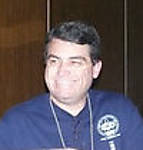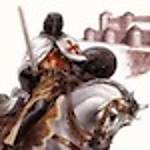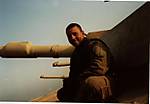Greetings,
Great thread here with lots of info. I have a question I posed on another thread here but haven't gotten any responses so I thought I would try here because it is related to the discussion at hand.
I was wondering if their was any difference, in the final result, applying filters directly on a flat acrylilc base coat or on top of a gloss coat applied to the base coat. In one application you are directly altering the base coat. In the second application there is a "barrier" protecting the base coat. I would think that "barrier" would result in a different look.
Thanks,
cbreeze
AFV Painting & Weathering
Answers to questions about the right paint scheme or tips for the right effect.
Answers to questions about the right paint scheme or tips for the right effect.
Hosted by Darren Baker, Matthew Toms
Finishing and Weathering Sequence
cbreeze

Joined: August 15, 2005
KitMaker: 87 posts
Armorama: 83 posts

Posted: Tuesday, December 07, 2010 - 02:42 AM UTC

SSGToms

Joined: April 02, 2005
KitMaker: 3,608 posts
Armorama: 3,092 posts

Posted: Wednesday, December 15, 2010 - 05:16 PM UTC
Yes Charles, it will look different. If you put a filter directly on flat paint, it will tint the paint itself. If you apply a filter on a flat clear that's over the paint, it will shift the color of the paint very slightly, like you are looking at it through a colored "filter". Finally, if you put a filter on a clear gloss surface, it will tend to run all over the place and leave you with some very strangely shaded corners.
MUNROS

Joined: September 24, 2010
KitMaker: 75 posts
Armorama: 43 posts

Posted: Thursday, December 30, 2010 - 07:57 PM UTC
HI Matthew. Thanks for taking the time out to post this info. To some people it may seem obvious. But when you are not so experienced, and trying to learn how to just do these techniques, not having to stress about the order in which to do them, is a great help. RONNY.

SSGToms

Joined: April 02, 2005
KitMaker: 3,608 posts
Armorama: 3,092 posts

Posted: Friday, December 31, 2010 - 08:59 AM UTC
You are welcome Ronny. I've tried to make this thread a type of "FAQ" and present everything broken down into simple, do-able steps.

Jedge3

Joined: July 17, 2010
KitMaker: 258 posts
Armorama: 208 posts

Posted: Tuesday, January 18, 2011 - 02:10 PM UTC
I have a question for everyone, when you do a wash do you target certain areas or just go gang busters over the whole model? I tried the whole model approach and it wasn't pretty. I was using a Mig wash.
Thanks,
Jeff
Thanks,
Jeff

SSGToms

Joined: April 02, 2005
KitMaker: 3,608 posts
Armorama: 3,092 posts

Posted: Thursday, January 27, 2011 - 08:08 AM UTC
Jeff,
It's okay to do overall washes first (then pin washes) if you do them in light coats. The wash should flow into all the panel lines and corners. If you see the wash pooling you can remove the excess with a brush or cotton swab. When dry the wash should only be opaque in the panel lines and surface details. It should make you model look more three dimensional.
It's okay to do overall washes first (then pin washes) if you do them in light coats. The wash should flow into all the panel lines and corners. If you see the wash pooling you can remove the excess with a brush or cotton swab. When dry the wash should only be opaque in the panel lines and surface details. It should make you model look more three dimensional.
X-FUZZ

Joined: December 30, 2009
KitMaker: 96 posts
Armorama: 64 posts

Posted: Thursday, February 03, 2011 - 03:16 AM UTC
I have read this piece numerous time and want to make sure i have i have it straight. When using a wash, you CANNOT put acrylic over Future as it will eat through it. All i use are acrylics. So i should use oils or enamels over acrylic or future? Confused.

SSGToms

Joined: April 02, 2005
KitMaker: 3,608 posts
Armorama: 3,092 posts

Posted: Friday, February 04, 2011 - 04:56 PM UTC
Hi Rob,
You have it right, an acrylic base coated with Future. Putting an acrylic wash (which is 80 or 90% acrylic thinner) on this surface, the thinner would attack the Future and paint. So you switch mediums to oils. Oil paint and mineral spirits have no effect on acrylics and vice-versa so you avert any disaster.
Guys have tried the water soluble oils but they don't work quite right. I use Winsor & Newton oil paint and odorless mineral spirits.
You have it right, an acrylic base coated with Future. Putting an acrylic wash (which is 80 or 90% acrylic thinner) on this surface, the thinner would attack the Future and paint. So you switch mediums to oils. Oil paint and mineral spirits have no effect on acrylics and vice-versa so you avert any disaster.
Guys have tried the water soluble oils but they don't work quite right. I use Winsor & Newton oil paint and odorless mineral spirits.
Thivi11

Joined: January 12, 2011
KitMaker: 219 posts
Armorama: 158 posts

Posted: Saturday, February 12, 2011 - 04:56 AM UTC
Best thread ever! This should be stickied somewhere.
A filter isn't necessary right? I'll be painting my first model soon and am looking at a base coat, some washes, and some weathering using MIG pigments, using Future where needed. I don't quite grasp "filters" yet. Am I making sense?
A filter isn't necessary right? I'll be painting my first model soon and am looking at a base coat, some washes, and some weathering using MIG pigments, using Future where needed. I don't quite grasp "filters" yet. Am I making sense?
Thivi11

Joined: January 12, 2011
KitMaker: 219 posts
Armorama: 158 posts

Posted: Saturday, February 12, 2011 - 09:49 AM UTC
ALSO, what about tools? Attach and spray with base coat/camo/future, then handpaint before flat coat and weathering, or paint alone, and attach after base/camo/future/decals, but before the flat coat and weathering?

SSGToms

Joined: April 02, 2005
KitMaker: 3,608 posts
Armorama: 3,092 posts

Posted: Sunday, February 13, 2011 - 08:13 AM UTC
No, you don't need filters. Filters are something that you can play with if you get bored doing all the other weathering methods!

SSGToms

Joined: April 02, 2005
KitMaker: 3,608 posts
Armorama: 3,092 posts

Posted: Sunday, February 13, 2011 - 08:19 AM UTC
I keep my tools off the model and paint them separately. I add them on during the last stages of weathering, whenever it's most logical.

reccymech

Joined: February 20, 2011
KitMaker: 87 posts
Armorama: 74 posts

Posted: Thursday, February 24, 2011 - 10:47 AM UTC
Well I can only agree with all before me with a big 'thanks' for all this technical info. It's a real bonus for a guy getting 'back in the saddle' as it were, after being many many years away from a hobby I enjoyed.
I must add I'm no where at the level of expertise of SSgt Toms, or is that 'Gunny'? At the moment its baby steps.
I must add I'm no where at the level of expertise of SSgt Toms, or is that 'Gunny'? At the moment its baby steps.

SSGToms

Joined: April 02, 2005
KitMaker: 3,608 posts
Armorama: 3,092 posts

Posted: Friday, February 25, 2011 - 11:07 AM UTC
Hi Mark,
Welcome to Armorama, welcome back into the hobby! This is a great forum to be in and I'm glad this thread is going to help you get back up to speed.
It's Staff Sergeant; I was U.S. Army Infantry, not Marines, but everybody just calls me Matt.
Don't be a stranger, post away on the forum and ask any questions you want. Everybody's very friendly and we're here to talk tanks and help each other!
Welcome to Armorama, welcome back into the hobby! This is a great forum to be in and I'm glad this thread is going to help you get back up to speed.
It's Staff Sergeant; I was U.S. Army Infantry, not Marines, but everybody just calls me Matt.
Don't be a stranger, post away on the forum and ask any questions you want. Everybody's very friendly and we're here to talk tanks and help each other!

didgeboy

Joined: September 21, 2010
KitMaker: 1,846 posts
Armorama: 1,509 posts

Posted: Tuesday, March 15, 2011 - 12:01 PM UTC
Matt;
this is great. Thank you for posting all of this AND replying to all of the questions. I am sure I will have some soon, but this is a really great topic thread. Cheers.
this is great. Thank you for posting all of this AND replying to all of the questions. I am sure I will have some soon, but this is a really great topic thread. Cheers.

SSGToms

Joined: April 02, 2005
KitMaker: 3,608 posts
Armorama: 3,092 posts

Posted: Wednesday, March 16, 2011 - 08:50 AM UTC
Hey Damon you're welcome!
bobbyh

Joined: September 09, 2009
KitMaker: 433 posts
Armorama: 167 posts

Posted: Wednesday, March 16, 2011 - 06:06 PM UTC
Hi everyone ! great thread. Matt, you mentioned "guy's trying the water soluble oils". I picked up some winsor/ newton oils this past weekend. I had no luck thinning them with water or isopropyl alchol. I did have good luck though thinning / working them with mineral spirits ( same brand you mentioned ). I used them in experimenting with the " dot method". Hope this helps someone else out too. - Bobby
Kharkov
Joined: April 09, 2011
KitMaker: 181 posts
Armorama: 175 posts
KitMaker: 181 posts
Armorama: 175 posts

Posted: Sunday, April 10, 2011 - 05:04 PM UTC
Winsor & Newton oils are designed to be used with white spirits, mineral spirits, and they are perfect for weathering anything painted with enamel paint, I used to use Humbrol enamels for all my armor painting.
It pritty much went like this -
If the final colour was to be Gray, then paint it Black first, as a pre shade.
If the final colour was to be dark Green, then paint it black first, as a pre shade.
If the final colour was to be Sand, Desert Yellow, then paint it Dark Brown first, as a pre shade.
This coat would be heavy, and act as a primer coat.
Then spray a dark shade of your final intended colour over the entire AFV, but not in all the corners, panal lines, bolt heads, features, pritty much avoid any area that you wish to remain dark.
Then repeat this process with increasingly lighter shades of your intended colour, as you get lighter in shade you can start just spraying the center of panels, and just the tops of any items, features, ie any areas exposed to heavy sun light.
These coats should all be light coats.
Then let it dry, for a long time, about a week, this is important if you use enamels and intend to use heavy oil washing, if you dont leave it long enough, you risk the paint lifting and bubbling.
Now comes the fun with oils, your AFV at this point should be slightly to light in shade, and with good reason, the oil washes will darken it, and dry brushing will finish it.
Next, get a big clean bottle of white spirits, mineral spirits, not an old bottle from out the shed, a brand new bottle.
Next, get a mixing tray, artists shops.
Next, mix some heavy mixes of your selected oils, these will be dark browns and borderline black.
Now give your AFV a quick wash over with clean white spirits, nothing heavy, just a quick wash over with a small flat brush.
Now with a fine pointed brush apply a heavy mix of your oils around all the bolt heads, panal lines, raised features, and any areas that you want to look mucky.
Warning - AFV will now look bad, Dont pannick
Now mix up some light washes with your oils, and with a clean flat sable brush give the AFV a "wash" with your light mixes, and this is the hard bit, and its best to experiment with oil weathing on an old model first tbh.
What your aiming for with these light washes is to move the oils around and remove excess oil, thats the best thing about oil weathering, nothing is set in stone, you can constantly adjust everything.
If you feel that the finish is getting too dark, first of all remember that dry brushing will lighten it, but if you are still convinced thats its too dark, then "wash" it over with pure clean spirits.
You can create all kinds of streaks and stains with your light washes, by simply moving your brush in the directions that fluids would run on the real thing, this will in effect streak your heavy applications of oil.
Warning, things will still look bad at this point, just not as bad
Next, leave it to dry, for a long time, about a week, go do something else.
Next, dry brush it, start with your intended base colour, hard to put into words because this is a pre shade way of painting, so your working from dark to light, so you need to aim for a colour thats kinda in the middle.
Dry brush the whole thing, but be careful to keep dark areas dark, so your dry brushing in effect the tops of everything.
Now lighten your colour, and repeat the dry brushing, rinse and repeat.
On a desert yellow paint scheme your final dry brush would be almost white, but not white, never use plain white,same for Gray and Green paint schemes, your final dry brush will be almost pure white.
Warning - Dry Brushing kills Brushes, but you all now that allready
Next, leave to dry, yep its only had a dry brush, but it still needs to dry, leave for a week, go do something else.
Next, Lacquer it, some people swear that you must only use Matt lacquers, this is not so, it depends on what your happy with, see the problem is Matt finishes tend to suck all the life out of a model AFV, but Matt is accurate.
You cant use Gloss, except for applying Decals, as a smooth base.
So that leaves Satin, I used to mix satin with matt, cant remember the ratio, but I never used pure matt, looks horid.
Some would say this is all too artistic for a 1/35th scale AFV, I say whats the point in spending months building a model AFV if you dont like the result.
Is it accurate ?, no, but nothing in armor modelling is accurate, not 100% anyway
Have fun
It pritty much went like this -
If the final colour was to be Gray, then paint it Black first, as a pre shade.
If the final colour was to be dark Green, then paint it black first, as a pre shade.
If the final colour was to be Sand, Desert Yellow, then paint it Dark Brown first, as a pre shade.
This coat would be heavy, and act as a primer coat.
Then spray a dark shade of your final intended colour over the entire AFV, but not in all the corners, panal lines, bolt heads, features, pritty much avoid any area that you wish to remain dark.
Then repeat this process with increasingly lighter shades of your intended colour, as you get lighter in shade you can start just spraying the center of panels, and just the tops of any items, features, ie any areas exposed to heavy sun light.
These coats should all be light coats.
Then let it dry, for a long time, about a week, this is important if you use enamels and intend to use heavy oil washing, if you dont leave it long enough, you risk the paint lifting and bubbling.
Now comes the fun with oils, your AFV at this point should be slightly to light in shade, and with good reason, the oil washes will darken it, and dry brushing will finish it.
Next, get a big clean bottle of white spirits, mineral spirits, not an old bottle from out the shed, a brand new bottle.
Next, get a mixing tray, artists shops.
Next, mix some heavy mixes of your selected oils, these will be dark browns and borderline black.
Now give your AFV a quick wash over with clean white spirits, nothing heavy, just a quick wash over with a small flat brush.
Now with a fine pointed brush apply a heavy mix of your oils around all the bolt heads, panal lines, raised features, and any areas that you want to look mucky.
Warning - AFV will now look bad, Dont pannick

Now mix up some light washes with your oils, and with a clean flat sable brush give the AFV a "wash" with your light mixes, and this is the hard bit, and its best to experiment with oil weathing on an old model first tbh.
What your aiming for with these light washes is to move the oils around and remove excess oil, thats the best thing about oil weathering, nothing is set in stone, you can constantly adjust everything.
If you feel that the finish is getting too dark, first of all remember that dry brushing will lighten it, but if you are still convinced thats its too dark, then "wash" it over with pure clean spirits.
You can create all kinds of streaks and stains with your light washes, by simply moving your brush in the directions that fluids would run on the real thing, this will in effect streak your heavy applications of oil.
Warning, things will still look bad at this point, just not as bad

Next, leave it to dry, for a long time, about a week, go do something else.
Next, dry brush it, start with your intended base colour, hard to put into words because this is a pre shade way of painting, so your working from dark to light, so you need to aim for a colour thats kinda in the middle.
Dry brush the whole thing, but be careful to keep dark areas dark, so your dry brushing in effect the tops of everything.
Now lighten your colour, and repeat the dry brushing, rinse and repeat.
On a desert yellow paint scheme your final dry brush would be almost white, but not white, never use plain white,same for Gray and Green paint schemes, your final dry brush will be almost pure white.
Warning - Dry Brushing kills Brushes, but you all now that allready

Next, leave to dry, yep its only had a dry brush, but it still needs to dry, leave for a week, go do something else.
Next, Lacquer it, some people swear that you must only use Matt lacquers, this is not so, it depends on what your happy with, see the problem is Matt finishes tend to suck all the life out of a model AFV, but Matt is accurate.
You cant use Gloss, except for applying Decals, as a smooth base.
So that leaves Satin, I used to mix satin with matt, cant remember the ratio, but I never used pure matt, looks horid.
Some would say this is all too artistic for a 1/35th scale AFV, I say whats the point in spending months building a model AFV if you dont like the result.
Is it accurate ?, no, but nothing in armor modelling is accurate, not 100% anyway

Have fun

wildsgt

Joined: May 27, 2007
KitMaker: 327 posts
Armorama: 259 posts

Posted: Tuesday, June 07, 2011 - 06:39 AM UTC
Hello all great topic. My ? after i put on my first filter how long do I wait before putting on next filter 


SSGToms

Joined: April 02, 2005
KitMaker: 3,608 posts
Armorama: 3,092 posts

Posted: Tuesday, June 07, 2011 - 10:10 AM UTC
Quoted Text
Hello all great topic. My ? after i put on my first filter how long do I wait before putting on next filter
If you are using oils and mineral spirits, usually overnight is sufficient.
Removed by original poster on 06/08/11 - 11:06:27 (GMT).
wildsgt

Joined: May 27, 2007
KitMaker: 327 posts
Armorama: 259 posts

Posted: Wednesday, June 08, 2011 - 12:09 AM UTC
Thank you Matt 


FD3S20B

Joined: April 27, 2011
KitMaker: 255 posts
Armorama: 250 posts

Posted: Monday, June 20, 2011 - 02:40 AM UTC
hello new to this and have more questions.just got done with my base coat of model air paint next step would be acrylic gloss for transfers then another coat to seal it up.i plan on using ak interactive washes and mig products will that eat away at the paint/ clear coat?and would dull coat protect against that? 

prophecy

Joined: November 09, 2010
KitMaker: 158 posts
Armorama: 157 posts

Posted: Monday, June 20, 2011 - 03:07 AM UTC
If you used Vallejo Model Air for base coat and an acrylic gloss varnish then you can use AK and MIG product without any problems because these are enamel based.

FD3S20B

Joined: April 27, 2011
KitMaker: 255 posts
Armorama: 250 posts

Posted: Monday, June 20, 2011 - 03:27 AM UTC
how is the vallejo gloss?is this something i can airbrush?(i use testors a4709)and at what psi?will the washes bring back the flat look or will have to use dull coat or another flat?would i put the wash on first after the last coat of gloss dries?just in the corners or the the entire model? i have a ton of questions due the hobby store not being any help thanks everyone. 

 |







